5 Greek Islands that Shine in September
Discover Greece’s islands in September with...
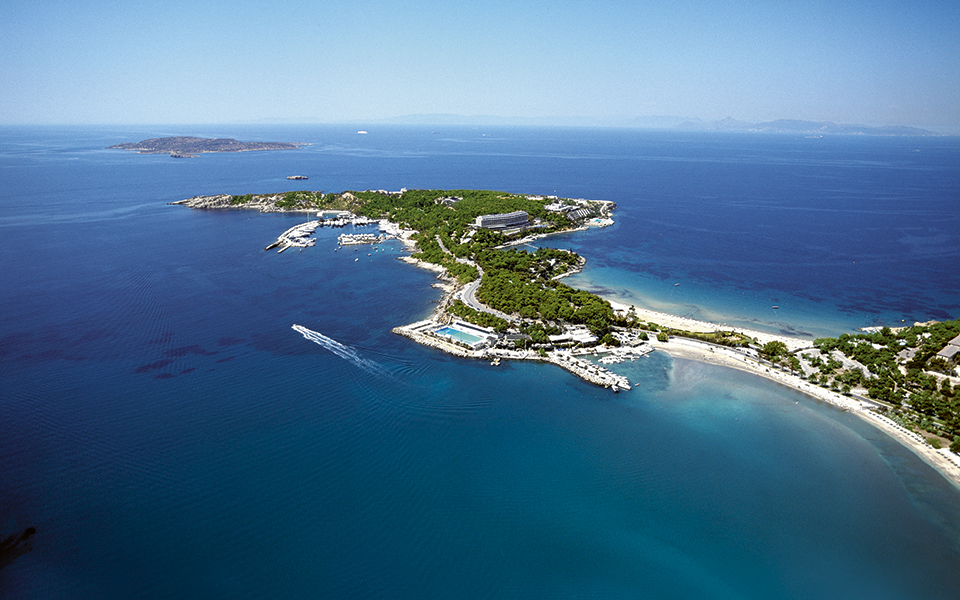
The Lemos promontory floats in the Saronic Gulf like an exotic island.
Amidst a forest of pine trees on the hilly promontory of Lemos, overlooking bobbing yachts and surrounded by a handful of luxurious residencies, hides Astir Palace, a timeless landmark of the Athenian Riviera. Located in the laid-back, upmarket suburb of Vouliagmeni, 25k from the city center, the Cape of Lemos was a favorite getaway with Athenian weekenders long before the existence of a resort in the area. They would prepare picnic baskets and squeeze themselves into public buses to reach the cape, lured by its turquoise waters, its sandy beaches and the shadowy trees. It was Astir Palace, however, built in the late 1950s, that would transform the area into the elite destination it is today. Athenians do not arrive on buses anymore, but in luxurious cars or yachts, in order to enjoy the perks of one of the finest, if not the finest, organized beaches in Attica, and indulge in the first-rate pampering offered by the nearby five-star resort.
Back in the mid-50s, Greece was still trying to recover from the devastation of both World War II and the subsequent Civil War, and the state was looking for ways to jump-start the economy by promoting the country as a tourist destination. At the same time, an emerging upper class began looking for recreational outlets and idyllic summer vacation spots near the capital. The government took notice, and started planning for high-end holiday accommodation. With the backing of the National Bank of Greece, a luxurious tourist complex by the name of Astir (meaning star) was designed. It included hotels, bungalows, gardens, restaurants, recreation centers and playgrounds, a marina for private boats and sports and bathing facilities.
“The Cape of Lemos was a favorite getaway with Athenian weekenders long before the existence of a resort in the area. They would prepare picnic baskets and squeeze themselves into public buses to reach the cape, lured by its turquoise waters, its sandy beaches and the shadowy trees.”
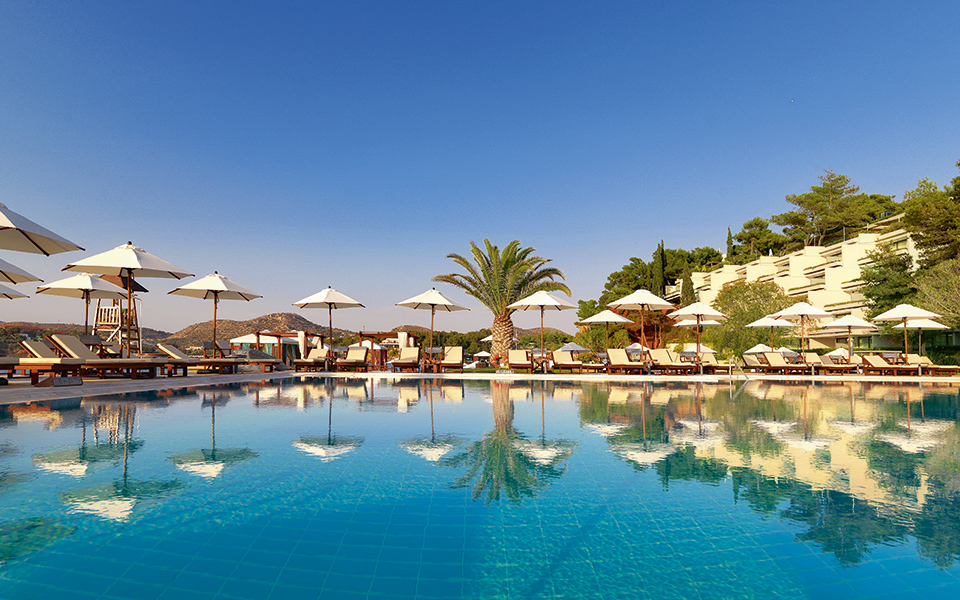
The Olympic-sized swimming pool of The Westin Athens.
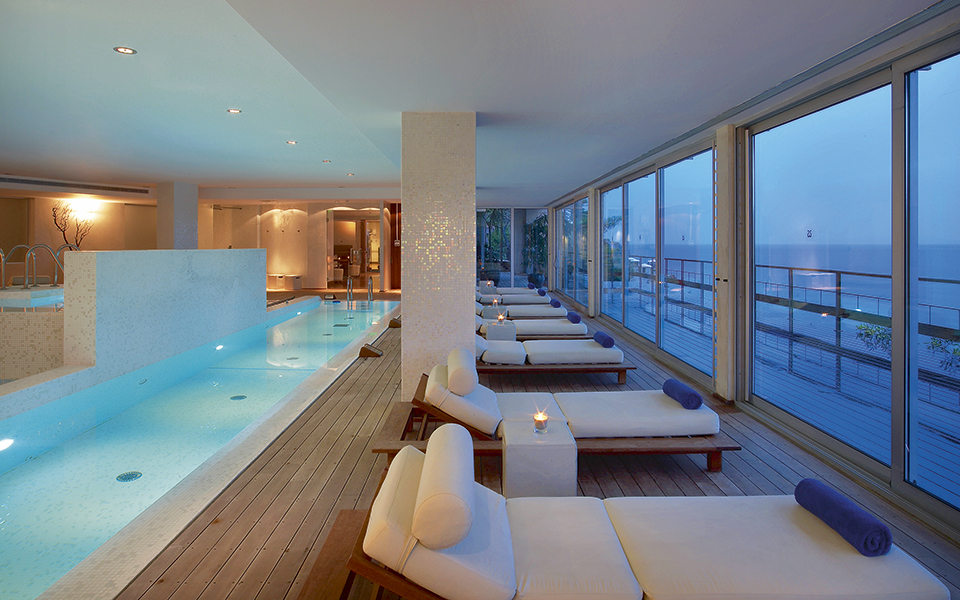
Arion Spa thalassotherapy pool and deck, overlooking the Saronic Gulf.
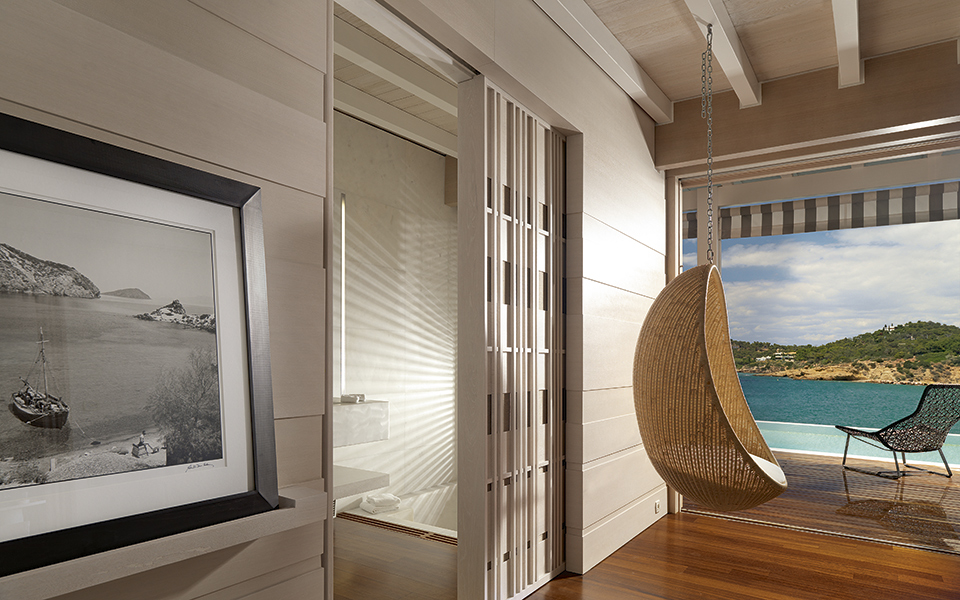
Living room corner of a bungalow suite, overlooking its private deck and pool.
“The bungalows (the famous “cabanas”) were erected next, in 1961, featuring a secluded private beach inside the complex, so VIPs could enjoy the sun away from prying eyes.”
The vision began to take shape with the transformation of the beach. Astir Beach, a stone’s throw from the resort and open to the public, was planned by architects Emmanuel Vourekas, Pericles Sakellarios and Prokopios Vassiliades. It opened in 1959, featuring elegant changing rooms and innovative canopies of white sailcloth resembling seagulls. Under the watchful eye of the god Apollo Zoster, whose 6th century B.C. temple was discovered in the 1920s and still graces the beach, the 300 meter-long sandy stretch was turned into a “Riviera,” catering to the aesthetics of an emerging cosmopolitan crowd. It became an instant favorite among Athenian socialites who began to flock to it – soon followed by local and international celebrity guests.
The bungalows (the famous “cabanas”) were erected next, in 1961, featuring a secluded private beach inside the complex, so VIPs could enjoy the sun away from prying eyes. It was on this beach in 1969 that Brigitte Bardot stunned fellow sunbathers by appearing in a tiny pink bikini, wooden platform shoes and a massive sunhat. The bungalows, smartly designed by architect Kostas Voutsinas, were intentionally hidden among the pine trees to offer privacy, yet allowed guests to enjoy great sea views from their verandas. These bungalows were stylish, exclusive and not far away from the city center, and thus became second homes for wealthy Athenians. Many guests rented them for the entire summer season, and commuted back and forth to their jobs in the city.
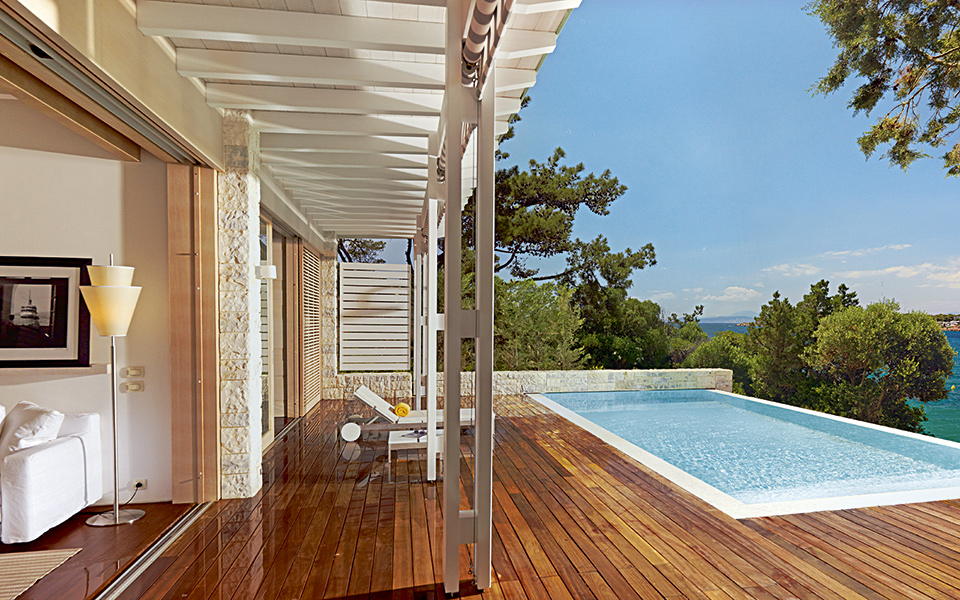
Astir bungalow with private pool
For those who wanted to socialize, the popular “Club House” – perched on a small hill among the cabanas and overlooking the sea – was the perfect spot. Nowadays, the restaurant Matsuhisa Athens operates in its place, serving unique fusion dishes by the renowned Japanese chef Nobu Matsuhisa on a fine veranda, which evokes a sense of traveling on the deck of a ship. As for lodging, the cabanas were completely renovated in 2008 with colonial-style interiors, minus the original kitchenettes, but retaining the same minimal exteriors featuring starch-white wood, pistachio-green trim and stone wall terraces.
In 1966, a waterski school – the first one in Greece – was added to the facilities’ list. It was operated by Grigoris Kasidokostas, the “Greek Steve McQueen” and later mayor of Vouliagmeni. Many members of wealthy Greek families, like Christina Onassis – the daughter of Aristotle Onassis – were taught how to ski during that time, away from intrusive paparazzis who were kept at bay by the resort’s security and its natural barriers. With the waterski school attracting more and more celebrity guests, Astir became one of the major Greek cosmopolitan hotspots.
“For those who wanted to socialize, the popular “Club House” – perched on a small hill among the cabanas and overlooking the sea – was the perfect spot. Nowadays, the restaurant Matsuhisa Athens operates in its place.”

Nelson Mandela, a former guest of the resort, posing with Kostas Perakis, then maître d’hôtel.

Singer Nana Mouskouri with Antonis Dimitrakakis (left) and Chronis Stergiopoulos, former managers of the hotels.

John Wayne was one of the Hollywood stars that stayed at the complex’s cabanas.

Former hotel manager Antonis Dimitrakakis standing next to Charlton Heston, a favorite celebrity among the staff.
“Leaders who have stayed in the Presidential Suite include Robert Kennedy, Jimmy Carter, Margaret Thatcher, François Mitterrand, Boris Yeltsin, Mikhail Gorbachev, Yasser Arafat and Nelson Mandela.”
As demand for accommodation increased, it was time to realize the second part of the initial plan; a hotel. The aristocratic Arion (today Arion, a Luxury Collection Resort & Spa) – again based on designs by architect Kostas Voutsinas – opened in 1967, north of the cabanas and right on the waterfront. Voutsinas created a building with an obtuse angle that allows all rooms overlooking the sea to enjoy panoramic views. Architects Emmanuel Vourekas, Antonis Georgiades and Konstantinos Dekavallas designed the interior, paying special attention to detail. They added an imperial marble staircase at the lobby and decorated it with works of art by preeminent Greek painters, like Gizis, Tsarouchis, Engonopoulos, Mitaras and Moralis (whose work still adorns the indoor swimming pool).
In the Presidential Suite (the only one in the greater Athens area with a 360° view) they commisioned bespoke furniture from Saride’s, a famous designer of the period. Leaders who have stayed in this suite include Robert Kennedy, Jimmy Carter, Margaret Thatcher, François Mitterrand, Boris Yeltsin, Mikhail Gorbachev, Yasser Arafat and Nelson Mandela. Arion was renovated in 2004, blending contemporary and classic elements while preserving signature design features like the original marble staircase. Its rooms, extending across four floors, were also revamped and given more luxurious amenities, like opulent bathrooms and luxuriant beds, to meet the needs of their exclusive clientele. Arion’s most attractive feature, however, remains its waterfront, directly accessible via an elevator from all floors. Recently updated as well, it features wooden decks with umbrellas, sun-loungers and enormous pillows for a literal and languid sinking-in – with or without the alcohol on offer at the Ski Bar.
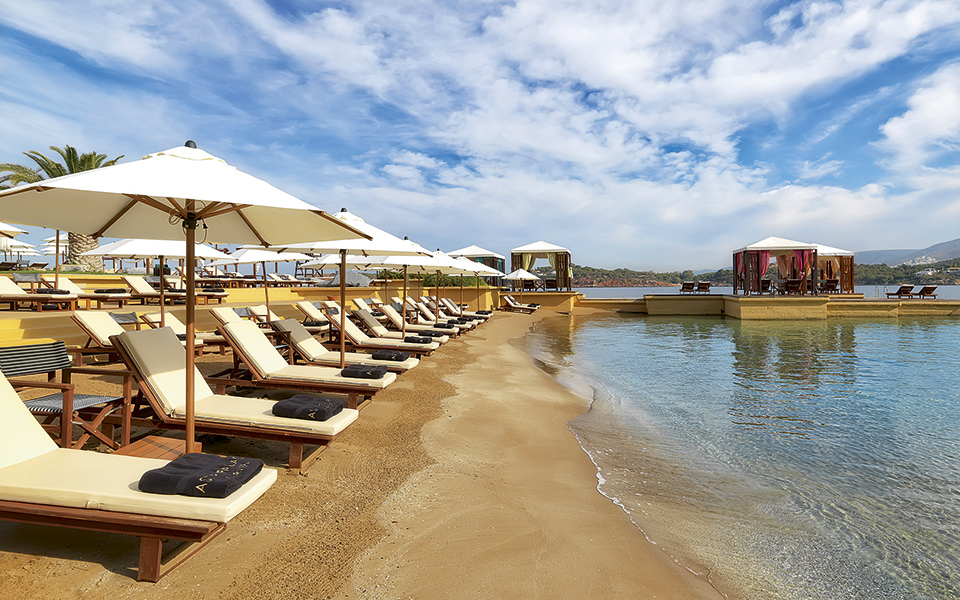
The Westin’s private beach; in the background, gazebos for extra privacy.
For a change of vistas, take a 50m walk along the sea towards the north of the resort to reach the complex’s second hotel, The Westin Athens. Another beguiling waterfront awaits you here, with its own enclosed and private sandy beach, its wooden decks with colorful gazebos for a sense of playful concealment and extra privacy, and an Olympic-sized swimming pool.
The Westin, which was first called Nafsika, was designed by Arion’s team of architects and was built in 1980. Built into the rock to blend in with the environment, it went on to become an emblem of ‘70s architecture. Its lobby is on the top floor and the rooms are located in tiers below, all of them enjoying uninterrupted views. If Arion was stern and aristocratic, Nafsika was hip and trendy, featuring a playful ‘70s color scheme. Its enormous swimming pool, a rare facility for its time, attracted socialites who came to hang out, mingle and be noticed. Glamorous pool parties were held here with celebrities cavorting till dawn, and even today it remains a favorite venue for weddings and various corporate events. Like Arion, The Westin was also renovated in 2004; it was given new furnishings and luxury amenities like the sumptuous Heavenly Beds® found in all the suites. In 2008, an impressive undulating canopy, resting on white columns, was added to the entrance, greeting the hotel guests with a further touch of class.
“The Westin, which was first called Nafsika, was designed by Arion’s team of architects and was built in 1980. Built into the rock to blend in with the environment, it went on to become an emblem of ‘70s architecture.”
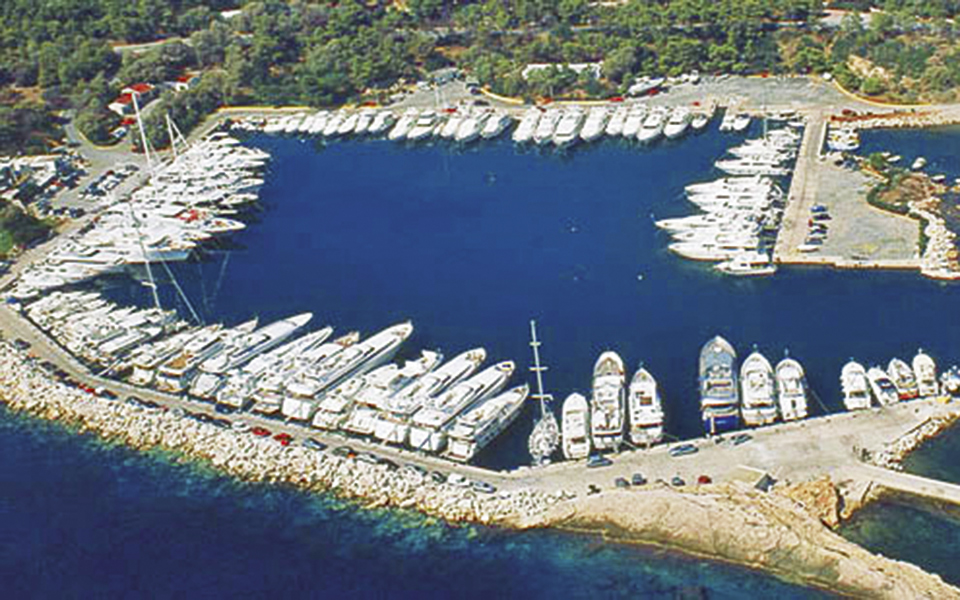
The Astir Marina, located right next to the resort, can accommodate up to 103 pleasure boats.
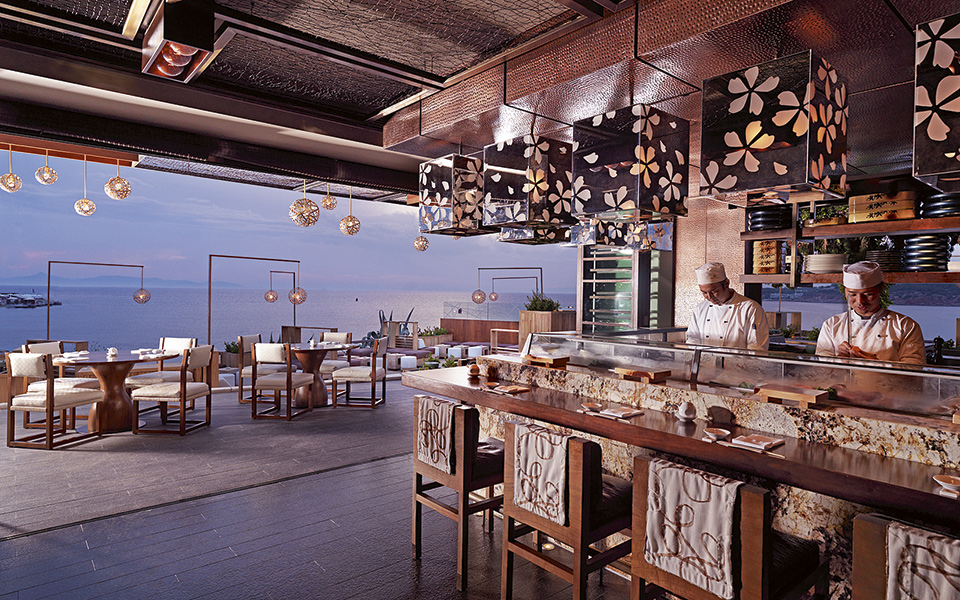
Matsuhisa Athens serves unique fusion dishes by the renowned Japanese chef Nobu Matsuhisa on a fine veranda
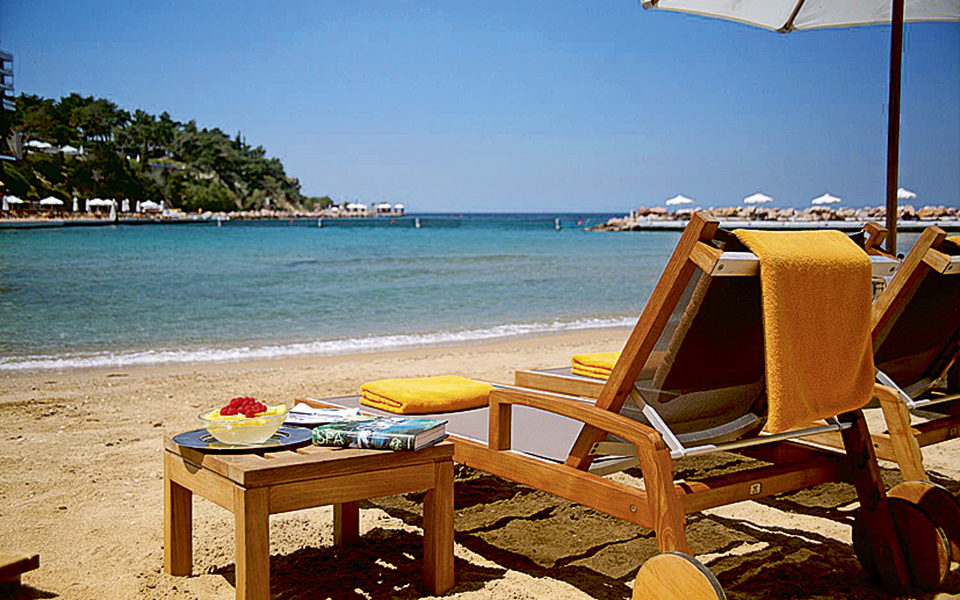
Arion, renovated in 2004, features an attractive beach served by a bar.
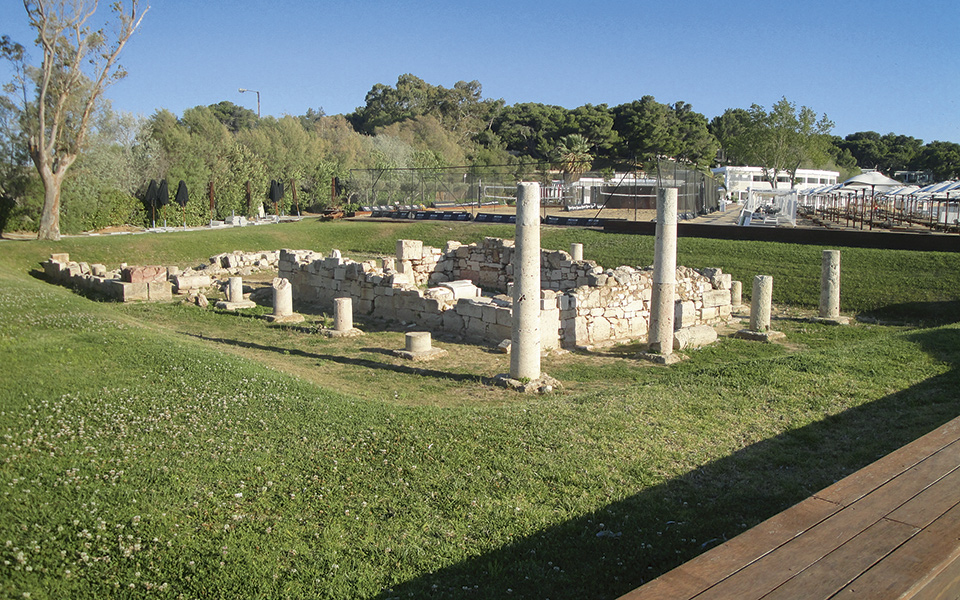
The Temple of Apollo Zoster was discovered in the 1920s and still graces Astir Beach.
Astir Palace undeniably owes its mythical status to the celebrities that fell in love with it and honored it by returning again and again. An example is Aristotle Onassis, the Greek tycoon, who was, it is said, loud in laughter and very generous with his tips. Among the Hollywood stars who stayed at the cabanas and the suites were Charlton Heston (very polite and a great fan of Greece, according to staff members), Tony Curtis, John Wayne, Paul Newman, Frank Sinatra (who had to use the kitchen doors to get to his room, in order to avoid his fans), and Anthony Quinn. Other celebrities who graced the Astir with their presence include the Beatles, singer Nana Mouskouri, composer Vangelis Papathanassiou and dancer Rudolf Nureyev.
Astir Palace continues to attract famous guests and is still synonymous with VIP glamor; for many, staying here is a matter of prestige. For others, it is a matter of loyalty and, occasionally, even obsession; there are those who would rather stay at a different complex altogether than change facilities within the resort.
Astir Palace remains an emblem of the good life, a resort revered for its fine architecture and envied for its unique location, far from the center and yet so near – permitting its guests to experience both the benefits of city life and the sweet idleness of an island retreat.
“Astir Palace continues to attract famous guests and is still synonymous with VIP glamor; for many, staying here is a matter of prestige. For others, it is a matter of loyalty and, occasionally, even obsession.”
Discover Greece’s islands in September with...
Experience Spetses in its most enchanting...
Discover festivals, beaches, food, and hidden...
Blending laid-back luxury with coastal charm,...